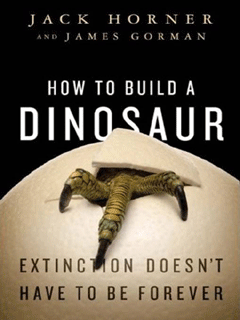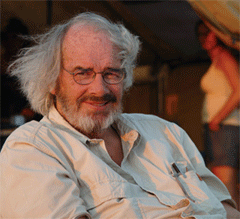How to Build a Dinosaur
Air Date: Week of May 29, 2009

T-Rex may be gone, but there are still dinosaurs all around us. Paleontologist Jack Horner tells host Bruce Gellerman that the birds we see every day are really avian dinosaurs. And he wants to give them the push they need to look like their extinct ancestors. Horner is the co-author of the new book, How to Build a Dinosaur. In it, he describes the science behind turning a chicken into chicken-o-saurus.
Transcript
GELLERMAN: If things had been just a little bit different, we wouldn’t ask - why did the chicken cross the road, but why the dinosaur did it.
In terms of evolutionary development, dinosaurs are close kin to today’s modern birds. In fact, paleontologist Jack Horner says chicken eggs just need a little nudge to bring out the dino DNA. And that’s precisely what he proposes doing in his new book, “How to Build a Dinosaur.”
Jack Horner is curator of paleontology at the Museum of the Rockies in Montana and he’s the recipient of a MacArthur genius award. Jack Horner joins us from Bozeman. Welcome to Living on Earth!
HORNER: Thank you. It’s nice to be here.
GELLERMAN: How to build a dinosaur. Do you think we can go through this interview without talking about Jurassic Park?
HORNER: [Laughing] Well I hope so. [Laughing] Michael Crichton had a cool idea. You know, I mean it was – it’s an interesting notion that you could find an insect that had bitten a dinosaur and sucked its blood out and then just get the blood out of the insect and get the DNA out. And, you know, it’s an interesting idea. And we’ve been looking for dinosaur DNA in extinct dinosaurs for quite a while now, and unfortunately we think that the chances of finding ancient DNA is pretty low.
GELLERMAN: You say that I can build a dinosaur – or that you can build a one.
HORNER: [Laughing] Well … science can build one. First off, it’s been established and has been known for quite some time that all birds are a group of theropod dinosaurs. So technically a bird already is a dinosaur and you don’t really have to do anything to make a dinosaur out of a bird, ‘cause they are one. But aesthetically they really don’t look like one because birds don’t have long tails and, of course, they don’t have teeth, and they have wings instead of hands.
GELLERMAN: There was an interesting discovery, a recent discovery in Canada - they found the smallest dinosaur in North America. It was a meat-eating creature about the size of a modern chicken. It ran on two legs and it was covered in feathers. Did dinosaurs have feathers?

HORNER: First off, all dinosaurs were warm blooded. We have very good evidence that all dinosaurs were warm blooded, and therefore, either young dinosaurs or small dinosaurs would have required some kind of insulation to keep their warmth in their body. And so feathers are their invention. And a lot of the feathers were probably display feathers as well.
GELLERMAN: We wouldn’t find feathers on t-rex, would we?
HORNER: I think we would when t-rex was small.
GELLERMAN: Oh.
HORNER: When they hatched out of their eggs, yeah.
GELLERMAN: Oh. They’re like little fluffy little dinosaurs.
HORNER: Yeah, little down covered, yeah. I think so. You know, if you look at birds - avian dinosaurs - basically every characteristic that we think of as being a bird characteristic was first invented by the extinct dinosaurs. Feathers is one of those characteristics. The wishbone is another. Hollow bones - that’s another. And, you know, the list goes on and on and on and that’s one of the reasons we know that birds, avian dinosaurs, are the descendents of extinct dinosaurs, the non-avian dinosaurs.
GELLERMAN: So t-rex was closer to an ostrich than an alligator?
HORNER: Yes, absolutely. Crocodiles and alligators are ancient relatives of dinosaurs, but they’re not dinosaurs. So, they only living animals we have that are living dinosaurs are birds.
GELLERMAN: So the idea is to take a chicken embryo, an egg, and turn it into chicken-osaurus.
HORNER: Right. Chicken-osaurus. So the first steps into this whole business is just figuring out which genes need to be flipped on or flipped off and how to do it.
GELLERMAN: So you’re not talking about changing the DNA.
HORNER: No.
GELLERMAN: You’re basically gonna kind of interrupt things in the egg phase. You call it evo-devo or devo-evo.
HORNER: Right. Well, that’s what everybody calls it. Evolutionary development is a cool thing and its kind of a new science having to do with looking at the development of an animal and sort of relating that to its evolution. As we all know, even the embryo of a human being looks very different that a human being when it’s developing. A human being, for example, at some point in the development of the embryo has a tail. And then a gene kicks on an actually disintegrates that tail.

Paleontologist Jack Horner.
GELLERMAN: So changes in the embryonic development can make dramatic changes in the evolution of an animal.
HORNER: Absolutely. That’s the cool thing about evolution. And the same thing happens with a bird. A bird begins to form a long tail, which its ancestors had, but then a gene kicks on and disintegrates that long tail. A bird also develops a hand. It starts out with a five-fingered hand and then a gene kicks on or maybe a complex of genes kicks on and destroys two of those fingers leaving it with a three-fingered hand, which is what a typical theropod dinosaur has. And then another gene kicks on and actually fuses those three fingers together to form the end of the wing. And so, you know, the book really is about going in and flipping the switches so that the tail doesn’t disintegrate and the three-fingered hand doesn’t fuse together to make a wing, but hatches out with a long tail and a three-fingered hand.
GELLERMAN: You know, it seems that as a paleontologist you have the answer to the question, what came first: the dinosaur or the egg.
HORNER: [laughing] That’s right.
GELLERMAN: In your case its gonna be the egg.
HORNER: That’s right.
GELLERMAN: Well how close are we to doing this, to building a dinosaur?
HORNER: Well again it depends on your definition of the dinosaur. Chickens already are dinosaurs. Therefore, we have them already. If you’re talking about, you know, how close are we to having a chicken with a long tail, I’d say very close. A chicken with hands instead of wings? Very close. But, you know, an animal that looks like a t-rex? That’s a long ways off.
GELLERMAN: So this is really possible?
HORNER: It certainly is, yes. If we can figure out how we went from dinosaurs to birds, there’s no reason, you know, no reason not to go the other way. But, you know, the idea is not just to build a dinosaur. The whole idea behind this really is to figure out how to turn genes on an off, to find the right genes to turn on and off, and in the end, you know chicken-osaurus is a cool idea and it would be fun, but once we understand how and which genes to turn on and off, you know, hopefully we can solve some of our genetic diseases.
GELLERMAN: So if we did build a dinosaur, it would taste like…?
HORNER: Chicken.
[LAUGHING]
GELLERMAN: Paleontologist Jack Horner’s new book is “How to Build a Dinosaur”
Links
Living on Earth wants to hear from you!
Living on Earth
62 Calef Highway, Suite 212
Lee, NH 03861
Telephone: 617-287-4121
E-mail: comments@loe.org
Newsletter [Click here]
Donate to Living on Earth!
Living on Earth is an independent media program and relies entirely on contributions from listeners and institutions supporting public service. Please donate now to preserve an independent environmental voice.
NewsletterLiving on Earth offers a weekly delivery of the show's rundown to your mailbox. Sign up for our newsletter today!
 Sailors For The Sea: Be the change you want to sea.
Sailors For The Sea: Be the change you want to sea.
 The Grantham Foundation for the Protection of the Environment: Committed to protecting and improving the health of the global environment.
The Grantham Foundation for the Protection of the Environment: Committed to protecting and improving the health of the global environment.
 Contribute to Living on Earth and receive, as our gift to you, an archival print of one of Mark Seth Lender's extraordinary wildlife photographs. Follow the link to see Mark's current collection of photographs.
Contribute to Living on Earth and receive, as our gift to you, an archival print of one of Mark Seth Lender's extraordinary wildlife photographs. Follow the link to see Mark's current collection of photographs.
 Buy a signed copy of Mark Seth Lender's book Smeagull the Seagull & support Living on Earth
Buy a signed copy of Mark Seth Lender's book Smeagull the Seagull & support Living on Earth

